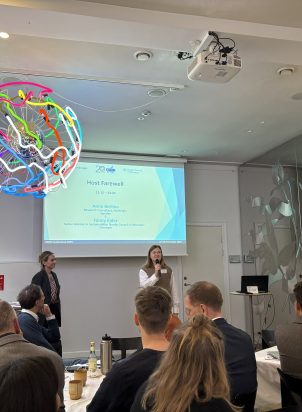Central governments in the Nordics often find their hands tied in influencing local-level priorities, especially concerning land use. This has sparked a series of innovative planning approaches and support mechanisms to encourage sustainable urban development across the region. But striking a balance with respect to state-municipal governance is essential, explains Johannes Lidmo, a researcher at Nordregio.
“It is necessary to avoid overly strict control. You need to consider how national support initiatives can strengthen already existing local efforts aimed at sustainable urban development”, says Johannes Lidmo. “It is clear, though, that they can be useful complementary tools to spatial planning.”
Lidmo is one of the co-authors of a new report titled “National Support Initiatives in Nordic Spatial Planning,” which analyses programs across Norway, Denmark, Sweden, Finland, and Iceland. It showcases a variety of approaches to sustainable urban development, from Norway’s FutureBuilt initiative, focusing on reducing carbon emissions in construction, to Denmark’s Partnership for Vibrant City Centres and its concerted effort to keep city centers alive and thriving.
It was important for the authors to study various types of national support initiatives rather than comparing similar ones. “The purpose of this was to shed light on the different approaches that can be found in the Nordic countries; so they can be an inspiration or be adopted at either the national or local level in other contexts,” explained Johannes Lidmo.
The other case studies the report dives into is Sweden’s Visions: in the North, which aims to integrate beauty, inclusivity, and sustainability into urban development. It looks at Finland’s Sustainable City Programme that pushes for smart, sustainable urban living solutions. Finally, Iceland’s Borgarlína project which a testament to bottom-up climate action and sustainable transport planning.
Against the backdrop of these municipal case studies and comparative analysis, the report highlights the different ways in which these countries are leveraging policy tools and collaborative efforts to achieve urban sustainability. It also presents some commonalities.
“It is fascinating that although the role of the national level differs between the Nordic countries, we saw common challenges at the local level, which I didn’t expect,” explained Maja Brynteson, researcher at Nordregio and co-author.
She notes that what stuck out the most is the importance of long-term funding commitments and policy coherence in the field of sustainable urban development at both national and municipal levels. “This is something that often changes when new governments are elected and priorities change, as we have seen with the recent election in Finland,” noted Brynteson.
Another key finding is that a more formal way of obtaining government funding for sustainable urban development projects at the local level should be developed in some countries. That could level the playing field for municipalities with varying resources, knowledge and lobbying capabilities.
In other countries, capacity building – including training and resources –would be crucial to help municipalities navigate support options and apply for them. On a practical level, that could include creating platforms that provide information about support for sustainable urban development and making municipalities aware of upcoming calls well in advance.
As the Nordic countries continue to explore their approaches to sustainable urban development, the insights garnered from these initiatives offer valuable lessons for policymakers, municipal planners, and academics alike. Find out more about the initiatives in the publication itself and the box below.
Nordic Case Studies
Denmark: Partnership for Vibrant City Centres
Overview: This Danish initiative aims to revitalize town centers to make them more vibrant and sustainable. It focuses on small and medium-sized towns, offering a toolbox of strategies for municipalities to engage local communities, businesses, and stakeholders in urban center development.
Key Features: The partnership provides guidelines for creating more attractive and liveable urban centers through improved urban planning, stakeholder engagement, and targeted interventions.
Ambition: By fostering collaboration across sectors, the initiative seeks to counteract the decline of urban centers, ensuring they remain hubs of community life and commerce
Finland: Sustainable City Programme
Overview: The Finnish Sustainable City Programme aims to promote sustainable urban development across Finland. It supports cities and municipalities in integrating sustainability into urban planning and development, emphasizing environmental, social, and economic sustainability.
Key Features: The programme encourages the sharing of best practices, supports pilot projects, and fosters collaboration between cities, government agencies, and other stakeholders to innovate and implement sustainable urban solutions.
Ambition: It aims to make Finnish cities leaders in sustainability, improving the quality of urban life and achieving national and international environmental targets.
Iceland: Borgarlína
Overview: Borgarlína is a public transport initiative in Iceland focused on creating a sustainable and efficient urban mobility solution for the capital region. It’s part of a broader effort to reduce traffic congestion, lower carbon emissions, and promote greener modes of transportation.
Key Features: The project includes the development of a high-capacity bus rapid transit system, improvements to cycling and pedestrian infrastructure, and the integration of various modes of transport to provide a comprehensive and user-friendly public transport network.
Ambition: Borgarlína aims to transform urban mobility in Reykjavik and surrounding areas, enhancing accessibility, reducing environmental impact, and improving the overall urban environment.
Norway: FutureBuilt
Overview: FutureBuilt is a Norwegian initiative focusing on promoting carbon-neutral urban projects and buildings. FutureBuilt is a private initiative that has partnered up with municipalities, aiming to develop 100 pilot projects by 2030 that demonstrate how carbon emissions can be halved in urban development.
Key Features: This initiative emphasizes innovative architectural solutions and urban planning to achieve sustainability goals, focusing on both new buildings and the refurbishment of existing ones. It involves various stakeholders in the construction sector to share knowledge and experiences.
Ambition: FutureBuilt strives to not only reduce carbon emissions but also enhance the quality of life through sustainable urban environments. Its projects also strive to serves as inspirational models for sustainable urban development within Norway and beyond.
Sweden: Visions: in the North
Overview: Visions: in the North is a Swedish initiative aiming to prepare for and manage the rapid urban growth anticipated in northern Sweden, due to major industrial investments. It seeks to create sustainable, inclusive, and attractive communities in the region.
Key Features: The initiative involves collaboration between municipalities, government agencies, and various stakeholders to develop strategic planning and innovative solutions for urban development, focusing on the long-term sustainability and resilience of communities.
Ambition: Through multi-disciplinary teams, the project generates idea sketches and innovative concepts for sustainable living environments, contributing to the strategic planning efforts of the involved municipalities.






